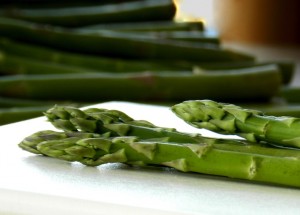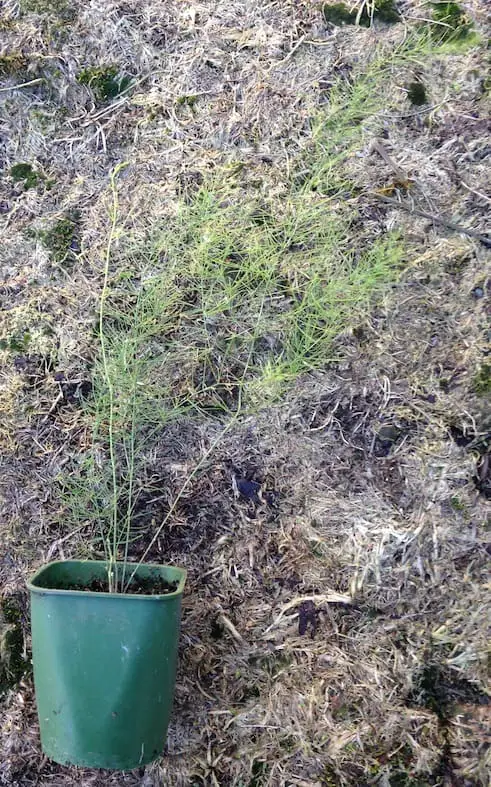 Asparagus, the vegetable crop suited only to the patient.
Asparagus, the vegetable crop suited only to the patient.
Which, I can be. But only in certain circumstances.
Luckily my garden is one of those circumstances. I love wandering my garden each day, keeping an eye on progress and waiting for my plants to grow, and reveal their crops.
So Asparagus are ok with me and 3 years ago I planted 3 plants into what we call the ground garden (the garden around the edge of the vegetable garden, which isn’t built up or boxed in).
And those little plants produced a few spears. Not many, but a wee taste.
We snapped the skinny spears off early while they were small and sweet and they were eaten just as they come.
You just can’t compare organic, home grown, fresh Asparagus with the woody, wilted spears you tend to buy from the supermarket.
Unfortunately, though, my poor Asparagus plants also fell victim to a bit of abuse.
Because Asparagus tops die off completely over Winter, leaving just the crown underground, it can seem if nothing is planted in their spot and they would often get stood on during the pruning of the trees or hoed over during weeding, despite the fact that I’ve reminded my husband and our aborist where they are several times.
And yes, I’ve put a number of markers in the ground, but these seemed to be ignored too without evidence showing above ground.
So, with it being Winter and the time to plant new Asparagus crowns, I decided to buy 6 additional crowns and transplant those and my 3 existing plants into a dedicated raised bed.

We usually use our raised beds to rotate our crops in but, from now on, one will be allocated purely to the Asparagus plants.
Relocating Asparagus
Planting your Asparagus in the wrong place is just one reason to transplant your Asparagus.
You may also need to relocate them if you have overcrowded your Asparagus bed, or perhaps you’re wanting to take some of your favourite crops with you when you move house.
Whatever your reason, it is possible to transplant your Asparagus and have them still do just as well, if not better, afterwards.
Asparagus love a free draining bed and will enjoy a slightly sandy soil so, to prepare the garden bed during my relocation, I dug in some sand with the fresh compost I had already added.
Then it was time to uproot the existing Asparagus crowns for replanting.
Relocating Asparagus certainly isn’t a quick and simple job. It needs to be done with care to have the best chance of a successful transplant.
After just a few years in the ground, an Asparagus root system spreads long roots in many different directions from the crown so you have to be careful to start digging a good distance from the centre of the plant, to make sure you don’t end up chopping all the roots off.
Using a fork, rather than a spade, I carefully started digging at least a foot out from the center of the plants and located the roots that are leading away from the crown. You need to trace one of these until you get to the end and then dig from that point around the plant at the same approximate distance to avoid as much root damage as you can.
Luckily for me, our garden has a very high sand content so my Asparagus plants came up pretty easily. It’s a much tougher job when they’re covered in heavy, clumping soil and well and truly bedded in.
Once you’ve dug right around the plant you can then test whether you can carefully pull it up from the ground. If it’s not coming up easily don’t pull with too much force otherwise you risk the crown breaking up. Just keep carefully digging and leveraging under the crown until you can get the plant to come completely free with ease.

Once you have your Asparagus plant out of the ground gently shake off or tease out any weeds and soil clumps and then give the roots a dip in a bucket of water.
Relocate it to it’s new spot and plant the crown with roots facing down. You should be able to just see the tiny nubs in the middle of the plant above ground, with the rest of the plant covered up nicely under the surface.
Water the plants in and then leave them to settle for the rest of the Winter.
We’ve had some pretty hard frosts since I planted out our new Asparagus bed, which has caused the tops of then newer plants to start to die off, but I’m excited about seeing this little patch do great things in the years to come.
At least they’ll have more of a chance in their own little garden, without the feet of giants crushing them.
Want to know more about gardening ?
Fill in your email address in the form below and you'll receive all the latest updates directly in your in-box.
Thank you for subscribing.
Something went wrong.